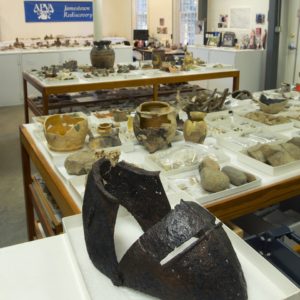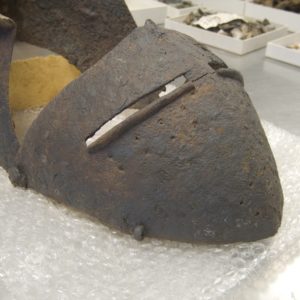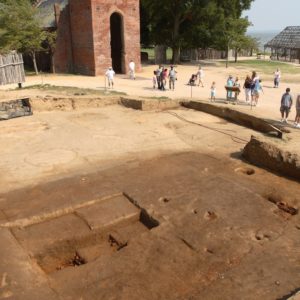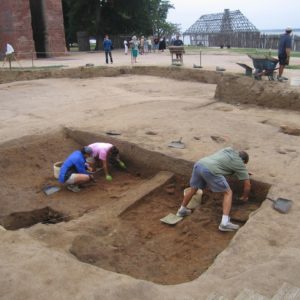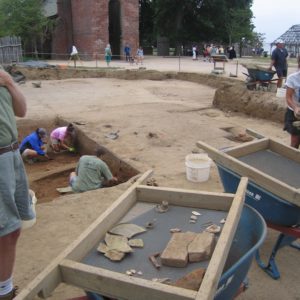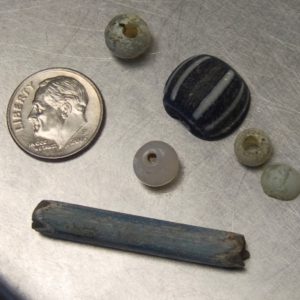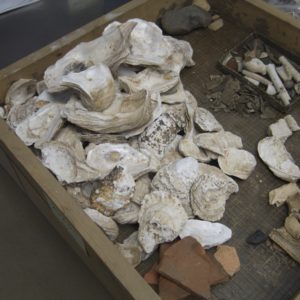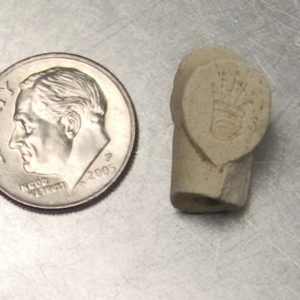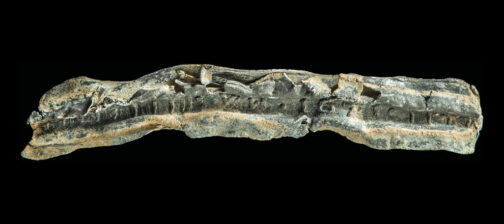Jamestown Rediscovery archaeologists are excavating the remains of a building that may have been put to the torch during Bacon’s Rebellion in 1676. Measuring 20′ x 40′ and being at least partially constructed of brick, the building appears to date to the mid to late seventeenth century, long after James Fort ceased to exist. Burned plaster, bricks, and charcoal found in the upper levels of the cellar suggest that the structure met a fiery demise. The building is very close to the church tower, suggesting that whoever lived there was a prominent resident. There is some speculation that the house may have even belonged to William Drummond, first governor of what is now North Carolina, and an ardent supporter of Nathaniel Bacon during his uprising.
Archaeologists are inside the cellar of this building, carefully removing layers of soil and brick rubble. The upper layers contained burned plaster, burned brick, charcoal, and rust-free nails—all evidence that the structure above was the victim of a fire. Did the structure burn with the rest of Jamestown during Bacon’s Rebellion in 1676? Although it is difficult to say for sure, the archaeologists can at least try to date the building itself. Wine bottles found in the cellar are of the style that was used in the late-17th century. Additionally, sherds of Westerwald salt-glazed pottery were discovered in the cellar that have a purple coloration. This color was not used on Westerwald pottery until around 1665. The building itself also provides a clue. The 20′ by 40′ dimensions nicely match those laid out in the 1662 Town Act pushed through the House of Burgesses at the insistence of the king and his agent Governor Berkeley. The act called for a series of 20′ x 40′ brick structures to be built in an effort to give permanence and fire-resistance to the towns of Virginia. Several structures were built at Jamestown as a result of the legislation and if this is one of them, then it would have necessarily been constructed after the act’s passage. The building’s proximity to the church meant that it probably housed a prominent citizen. There is some speculation that it may have belonged to William Drummond, first governor of the Albemarle County colony (which eventually became North Carolina) and a key supporter of Nathaniel Bacon during Bacon’s Rebellion.
At the bottom of the cellar, the archaeologists have found a brick-lined floor that is largely intact. The structure above, however, was mostly “robbed” of its bricks after it burned so that they could be used for another building. This was a common practice at Jamestown where brick was a valuable building resource.
Some of the artifacts coming out the cellar include nails, window glass, wine bottles, pottery, a door pintle (part of a door hinge mechanism), and a dagger blade. The conservation staff has nearly completed work on a helmet faceplate and neck protector found in May 2007. Very little rust remains and its removal has revealed a hook on the neck protector with a corresponding receiving clasp on the faceplate. Ventilation and breathing holes are visible in the mouth area and underneath both eye slits. Just to the east of the cellar excavations a number of beads and oyster shells have been found, as well as a pipe with a gauntlet-shaped maker’s mark on its heel.
related images
- Helmet. The hook of the neck guard fits into a clasp on the facemask.
- Close Helmet in the Vault
- Helmet receiving clasp for hook is at the bottom center of the photo. Note the numerous breathing and ventilation holes on the facemask.
- The helmet. The neck guard is fused in a position above the face mask but would have actually fallen below it.
- Excavations beginning at the cellar
- Reaching the cellar floor
- Cellar excavations. Notice the proximity to the church tower.
- Excavations at the cellar
- A variety of beads found during excavations near the cellar.
- Some of the oyster shells excavated from near the cellar. Animal bones and pipe stems are also visible.
- Pipe fragment with gauntlet maker’s mark




